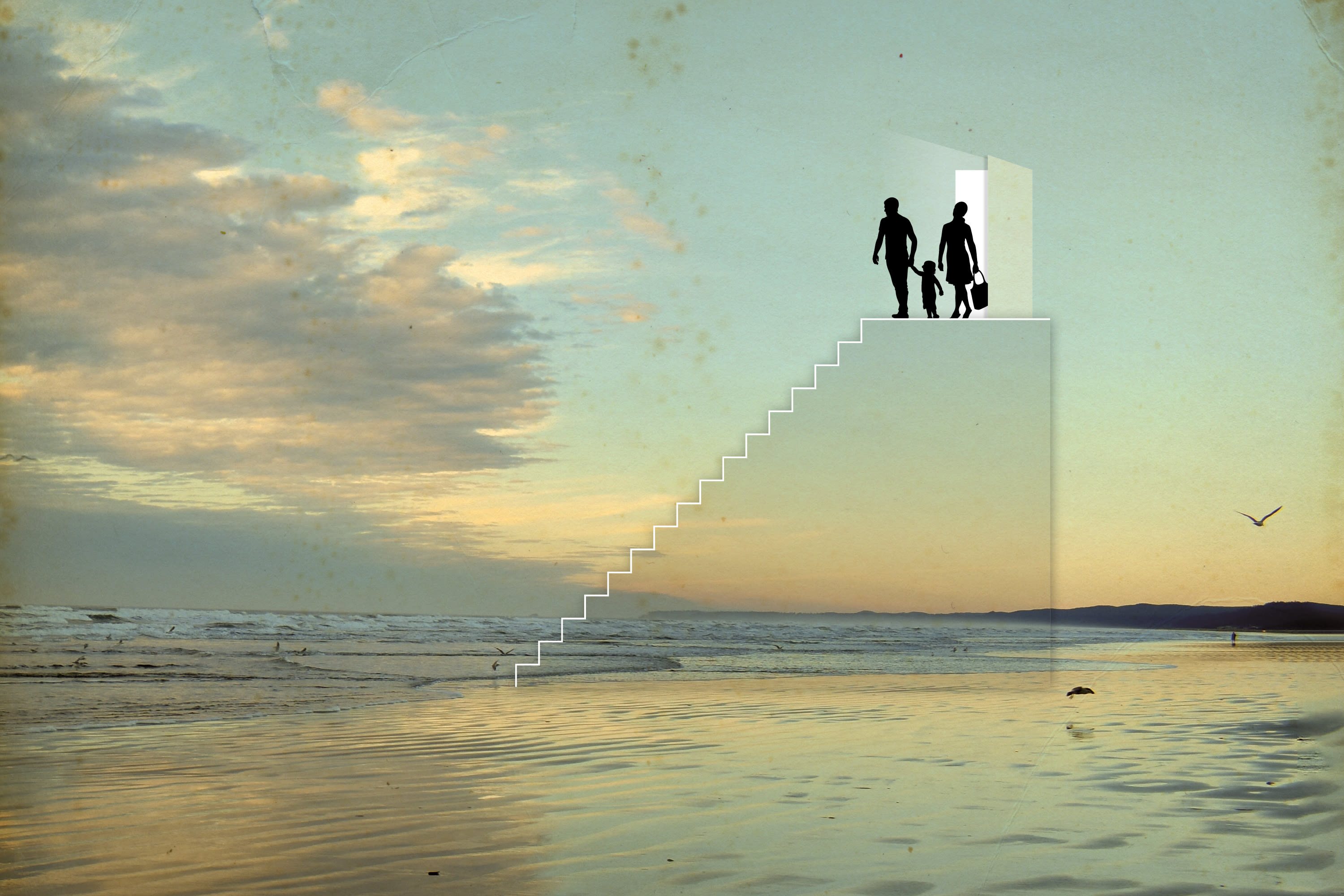Washington’s 25 Best Beaches

Sea stacks rise from Rialto Beach.
Ignore anyone who says Seattle isn't a beach town. From tide pool bonanzas to seriously good surfing, our Washington state beaches have plenty to offer.
Lake Washington
1. Madison Park Beach
On a sunny summer weekend, is anyone on the sloping grass above Madison Park’s miniscule line of sand obeying the city’s no-booze park rules? Maybe the toddlers padding toward the tiny waves caused by Lake Washington motorboats and the lifeguards who oversee the roped-off swim zone. But certainly not the shrieking scenesters on inflatable rafts or most of the chatty locals without the time or inclination to find solitude.
2. Denny Blaine Park
The beach is nicknamed Dykiki for its popularity among the city’s lesbian scene, but this tiny piece of Lake Washington waterfront, along with Howell Park just to the south, usually hosts more men than women. And by more, we mean more—both are unofficial nude hangouts, thoughtfully tucked between waterfront mansions. For more pocket waterfront parks, check a city-made map of public-access street ends.
Lake Sammamish
3. Sunset Beach
Sand strips are short but sweet on the Eastside, but the green acres of Lake Sammamish Park spread wider than the longest possible frisbee throw. A curved bathhouse evokes retro style but dates back only a few years, housing concessions and showers, plus a rain garden on the roof. The waterfront lives up to its name at the end of the day as the sun does its final bow over the water.
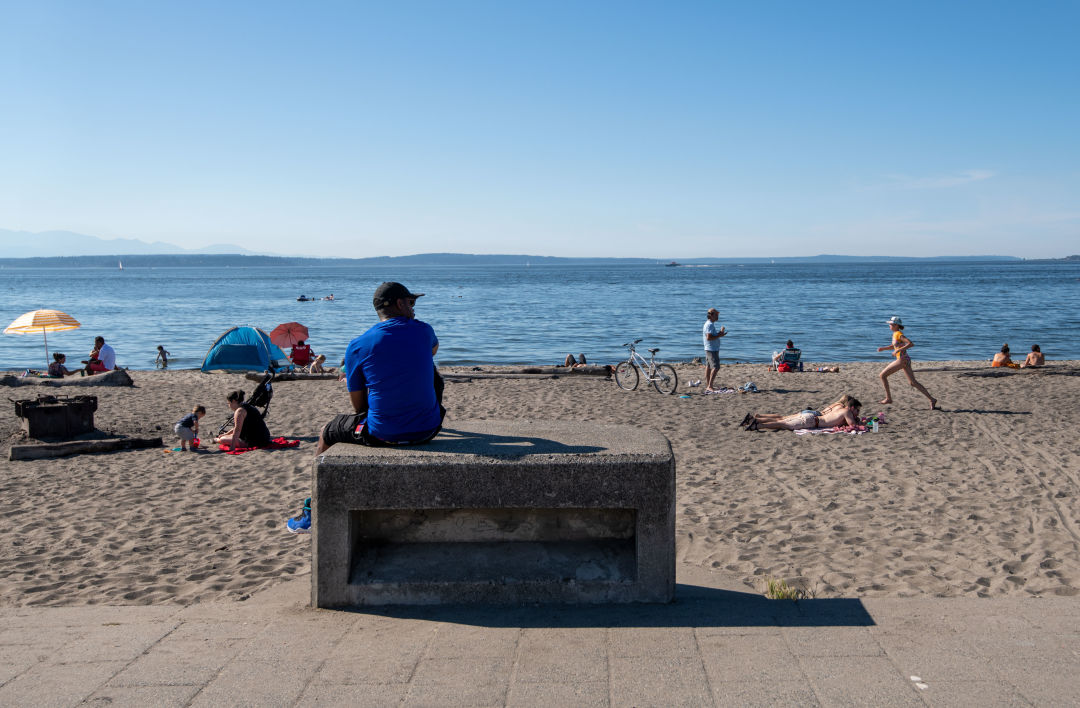
People watching for days on Alki.
Image: Jane Sherman
Puget Sound
4. Alki Beach
Seattle began here (or at least the modern incarnation) when the Denny Party landed in West Seattle in 1851. Though its Coney Island–style amusement park was removed in the 1910s, Alki remains a prime hangout spot, with volleyball nets, a Statue of Liberty replica, and a historic bathhouse. Pretty much everyone cruises slowly down Alki Avenue past the beach, showing off a cool ride—or just looking for parking.
Sand 101: There’s a rumor going around that Alki is a fake beach, that the sand was trucked in instead of washed ashore the natural way. Not really; only some of it was imported, years ago, as a top dressing layer. Today Seattle’s parks department washes the existing grains with a mechanical sifter, but it generates so much dust that it only comes out once a week during the summer season.

Jetty Island Park is Everett's own offshore sandbox.
Image: Port of Everett
5. Jetty Island Park
Not one of those hard-to-reach islands that eat up half a day in ferry line waits, Everett’s offshore isle is a free 10-minute passenger ferry ride away, and the man-made island is little more than two miles of beach. Even the bathrooms are offshore, floating in Possession Sound.
6. Jackson Beach
Like so many Washington beaches, this San Juan Island park is where driftwood comes to its bleached-white rest, creating a barricade between dark, dense sand and a grassy bluff. The protected North Bay just south of Friday Harbor truly shines—literally—at night, when bioluminescent dinoflagellates illuminate the water when brushed with a kayak paddle, though guided groups are usually the only ones allowed after the park closes at dusk.
7. Cama Beach
The beach is all about boats on Camano Island, where the parking lot to its most popular sound-front space is uphill and out of sight. The Center for Wooden Boats and its classic craft are center stage by the water, surrounded by cedar cabins that resemble an upscale sleepaway camp. The center rents boats and holds weekend toy-boatbuilding workshops, and a super rocky shoreline makes seafaring the preferred method of arrival and departure.
Sand 101: When there’s a steep incline at water level—like in much of Puget Sound, including Camano Island’s Cama Beach—large pieces of rock and shell pile up while smaller particles are light enough to wash away.

Mount Baker is visible from Point Roberts, a tiny enclave of America within British Columbia.
Image: Shutterstock by Max Lindenthaler
8. Point Roberts
Strict adherence to a nineteenth-century treaty gave the tip of this Canadian peninsula to the U.S. (these five square miles are south of the 49th parallel), and its four beaches, mostly rocky, are less popular with visitors than the cheap gas and American mailing addresses. Still, Maple Beach on the east side lets you country hop with impunity past a plaque that denotes the national border.
9. Semiahmoo
The resort’s two golf courses are up on the Blaine mainland—and you can play the links with a soccer ball on select evenings—but the hotel, spa, and eateries sit on a beachy spit that spikes so far into the sound that it practically kisses the U.S. border. Guests counter cold Canadian winds by gathering around s’mores bonfires at dusk.

The point at Point No Point.
Image: Shutterstock by Loren L. Masseth
10. Point No Point
The Kitsap Peninsula’s lighthouse corner is known to history as the place where several tribes signed their land away in a treaty, but that’s not how it gets the name; it’s just not a very sharp point. The U.S. Lighthouse Society is headquartered in the 1879 light station, the oldest ship saver on the sound, and vacationers can rent half of the lighthouse keeper’s quarters.
11. Anderson Point
Work for it, but not too hard: The beach is a three-quarter mile walk from the parking lot at this Kitsap County park (all downhill, but that means an ascending stroll on the return trip). Vashon Island feels close enough to touch across the narrow finger of Colvos Passage, making the waves super calm. Thanks to the required hike, the beach stays relatively empty.
Strait of Juan de Fuca
12. Fort Worden
The sand stretches on Port Townsend’s historic military fort form a sharp angle at a lighthouse, but the concrete batteries—the fortifications built to protect the Victorian city and the rest of Puget Sound in the early twentieth century—are the real adult playground. If the spooky tunnels that burrow beneath the beach bluffs aren’t haunted, local ghosts should be ashamed of themselves.
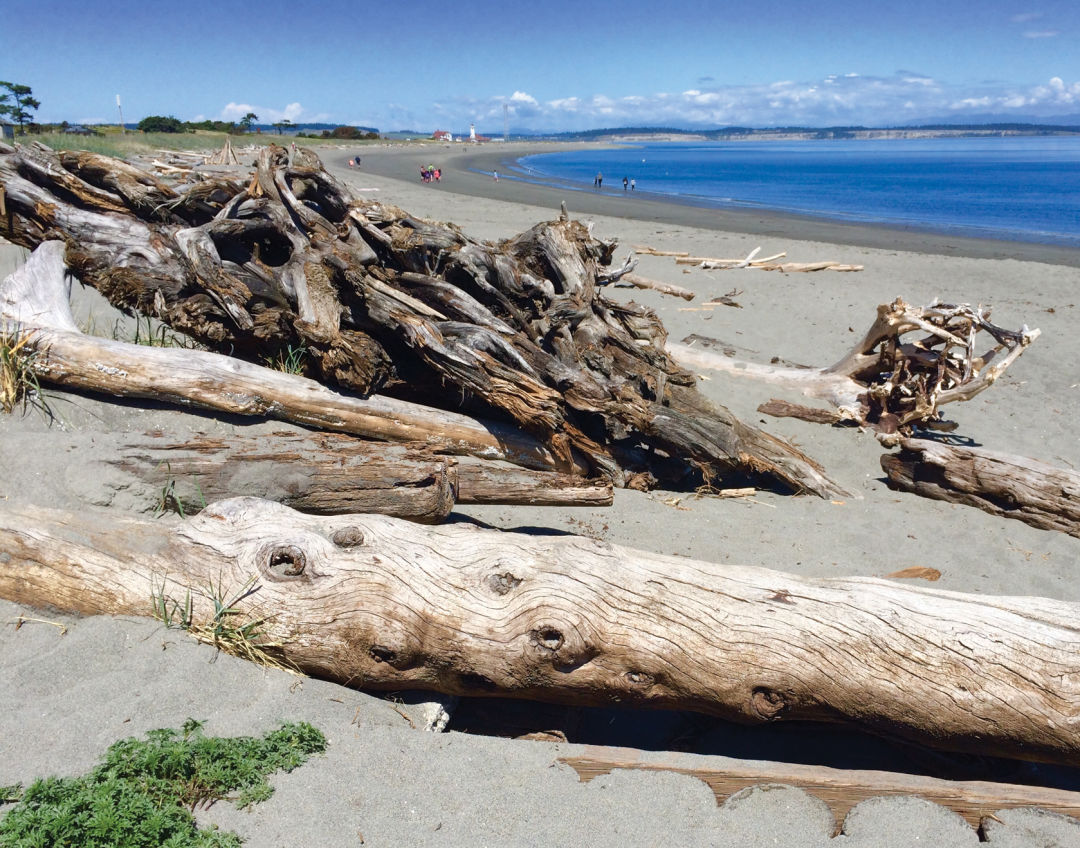
Driftwood lines the beach at Fort Worden.
Image: courtesy Fort Worden
13. Salt Creek Beach
Picture the rugged islands of Washington’s coast, but without the wild waves. The most dramatic sections of this county park on the Olympic Peninsula’s northern border are actually tucked inland—old military bunkers sunk deep into the overgrown forest, many hidden behind overgrown trails. At the water, tide pools form the eastern end while a sandy expanse hugs the relatively calm Crescent Bay; Vancouver Island forms the horizon, far in the distance.
Pacific Coast
14. Hobuck Beach
Snag a Makah recreation permit at the local museum or gas station; state park passes don’t work on this Indian reservation, and beachfront cabins at Hobuck Beach Resort beg a longer stay. Search the long beach’s south end, far from the surfers, for a hidden trail that ducks over a headland to a smaller expanse of tide pools.
15. Rialto Beach
Rock columns just offshore form sea stacks, or tiny islands that hold little more than a few scraggly trees up top and basking sea lions at their base. Hole-in-the-Wall, a natural sea arch carved into a headland on this national park stretch, is about two miles north of Rialto’s parking lot and an open gateway only at low tide. South of Rialto, the Quileute Oceanside Resort abuts La Push’s boringly named First Beach.
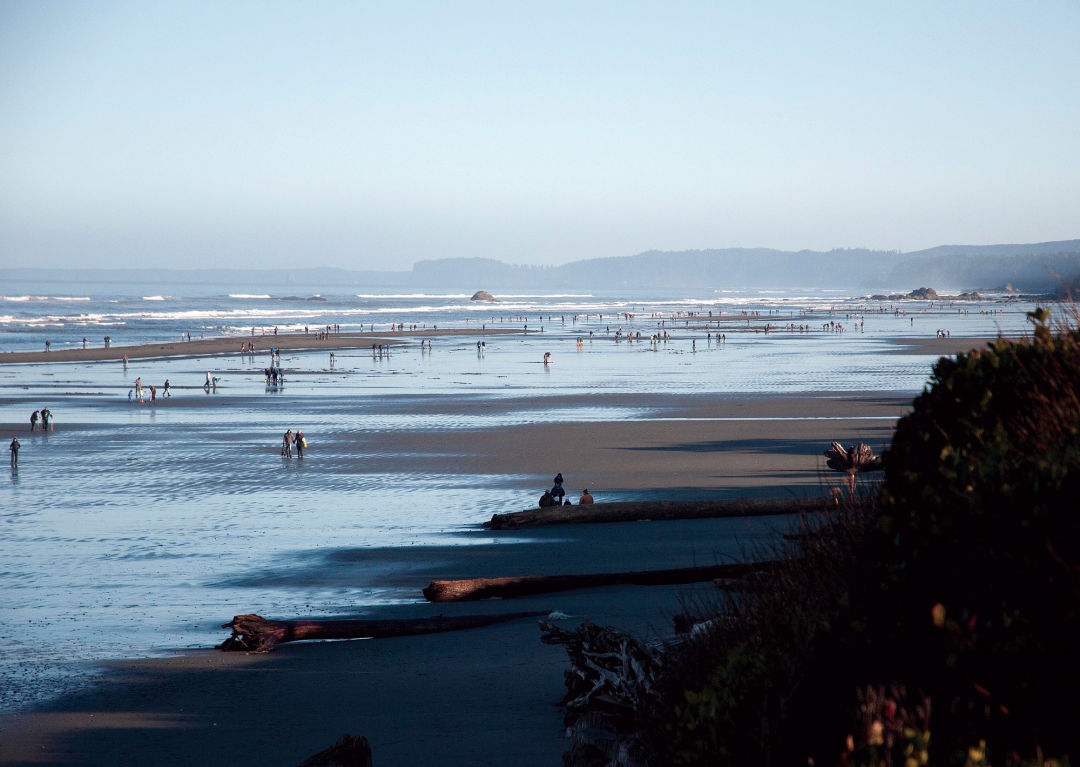
Low tide at Ruby Beach.
Image: National Park System
16. Ruby Beach
For all its glorious remote beaches, the Olympic National Park manages to offer a few jewels close to the parking lot. The wide sands of Ruby Beach are only a quarter mile from Highway 101, and at Kalaloch, to the south, there are only a few feet between pavement and dunes. (Plus there's that Tree of Life that's falling down.) Look up for bald eagles and down for on-leash dogs—it’s one of the only places in the park they’re permitted.
17. Seabrook
The middle stretch of Olympic coast is a lot of nothing, nothing, trees, nothing—and then, suddenly, Pleasantville. Built as a vacation community in 2005, Seabrook looks like a New England hamlet that sprung up on a mossy bluff overlooking the Pacific. In season, the town offers a few quaint shops, an indoor pool, and wood-shingled rental cottages.

Surfers flock to Westhaven State Park at Half Moon Bay.
Image: Lindsey Ashline
18. Copalis Beach
The Pacific Ocean beach is a Washington state highway for stretches south of this mid-peninsula spot—keep it to 25 miles per hour—but Copalis is more. It’s the only FAA-designated beach airport in the country; pilots aim for the darker, wet sand when landing and try to avoid the driftwood. Otherwise it’s a quiet waterfront bordered to the north by Iron Springs Resort, some of the poshest rental cabins on the coast.
19. Ocean Shores
Though best known for its modest oceanfront hotels, beach horseback tours, and a giant casino, the sand-blown town just north of Hoquiam has the state’s best beach kitsch at Sharky’s, a T-shirt and saltwater taffy emporium entered via the mouth of a great white shark. Plus the town has one of the best Irish pubs in the state.
20. Half Moon Bay
The shipbuilding town of Westport hums with working-class grit, and cottages circle the busy marina. The beach at Westhaven State Park, a crescent shape facing the entrance to Grays Harbor, attracts surfers and serves as a viewpoint to watch cargo ships inch their way into the state’s only port on the Pacific.
Sand 101: The beach at Half Moon Bay was formed by the construction of a jetty in the early 1900s that caused the shore to erode away into a crescent. The Army Corps of Engineers has to fill the area with dredged material after storms since it washes away so fast. The jetty also blocks the seasonal drift of sand north and south along the coast.

Tokeland Beach Hotel, perhaps the oldest in the state.
Image: Courtesy Tokeland Inn
21. Tokeland
In a hotel that’s exactly as old as Washington state—127 years—there are plenty of antiques and rooms with flowered wallpaper, plus a hiding place behind the fireplace where smugglers concealed undocumented workers. The Victorian-era farmhouse overlooks the calm, kelp-filled shore of Willapa Bay, and it’s one of the only commercial establishments in a sleepy residential waterfront community.
Sand 101: Gravel beaches are the most common kind in Puget Sound, but they can also be spotted on the coast (like on Tokeland’s Willapa Bay side). Though they suck for playing volleyball, the small-stone beaches tend to support more marine animals, since they provide hiding spots from predators. Crabs love ’em, and harbor seals feed along mixed gravel beaches.
22. Leadbetter Point State Park
Much of the Long Beach peninsula tip is reserved for snowy plover restoration, but trails wind toward beaches with silk-soft sand (and unlike the rest of Long Beach, there are no cars turning doughnuts here). The park stretches from the Pacific to Willapa Bay’s famed oyster beds.

Kites rule the sky at Long Beach.
Image: CA Eccles
23. Long Beach
A painted archway says this 28-miler is the longest beach in the world, and while that might not be exactly true—Brazil’s Praia do Cassino holds that title—the flat, wide sands of the peninsula taper off to the horizon in both directions, pounded by Pacific waves that are almost always too wild and too cold for swimming. It has the state’s best boardwalk, and the 8.5-mile Discovery Bike Trail winds among sand dunes and public artwork and the reassembled bones of a beached whale.
Sand 101: The big mud flats of Willapa Bay bring clay and silt to the sand mix, making for a soft, fine blanket on Long Beach. It’s pale because it has higher concentrations of quartz than the beaches near river mouths.
24. Seaview
On a coast better known for hand-caught razor clams and bins of saltwater taffy than fine dining, the Depot restaurant is a welcome diversion. About a dozen tables crowd the old Clamshell Railroad station, where chef-owner Michael Lalewicz panfries local oysters and piles Willapa Bay clams and wild razor clams into a well-balanced chowder.
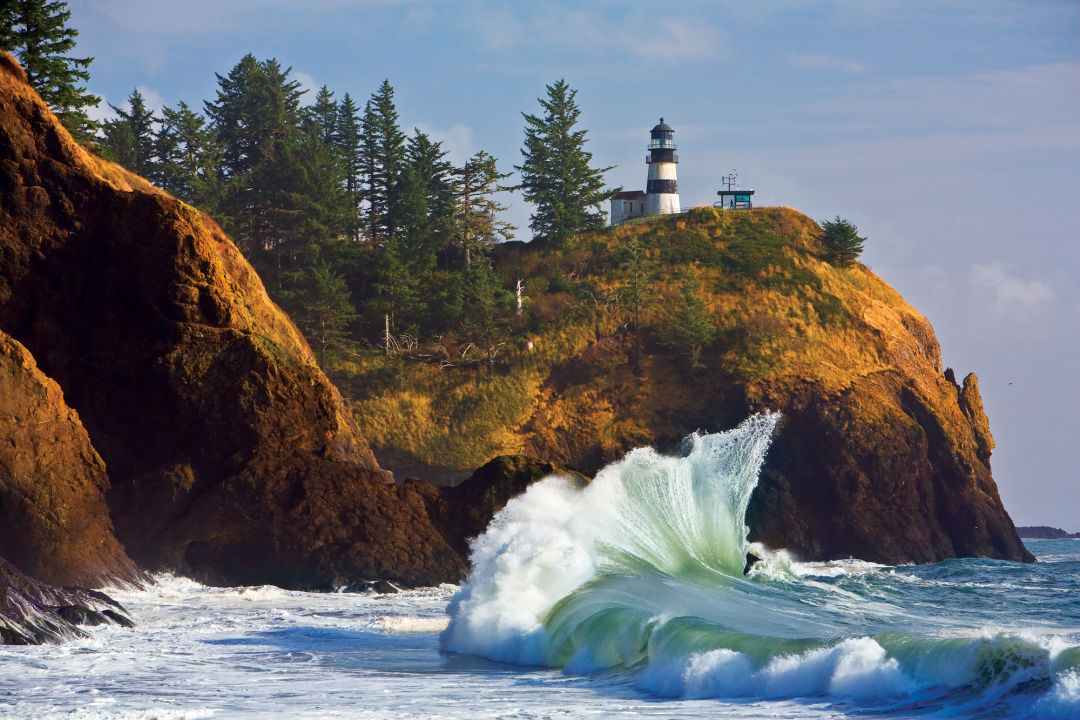
The seas get rough around Cape Disappointment.
Image: Shutterstock/Viewfinder
25. Cape Disappointment
When Lewis and Clark first saw the Pacific Ocean in 1805, did they immediately start building beach forts out of driftwood? Probably. It feels like everyone who’s visited since has done so at this pocket-size version of Waikiki Beach. As idyllic as the cove and black river sand are, the name comes not from paradise comparisons but the death of a Hawaiian sailor nearby.
Sand 101: The black grains on Waikiki Beach are from the black basalt that washed down the Columbia River fairly recently; the sand color will change seasonally, getting blacker during the high runoff in spring.


